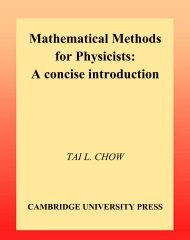The Comprehensive LaTeX Symbol List
The Comprehensive LaTeX Symbol List
The Comprehensive LaTeX Symbol List
Create successful ePaper yourself
Turn your PDF publications into a flip-book with our unique Google optimized e-Paper software.
To use the new txfonts/pxfonts symbols without altering the document’s main font, merely reset the default<br />
font families back to their original values after loading one of those packages:<br />
\renewcommand\rmdefault{cmr}<br />
\renewcommand\sfdefault{cmss}<br />
\renewcommand\ttdefault{cmtt}<br />
7.2 Where can I find the symbol for . . . ?<br />
If you can’t find some symbol you’re looking for in this document, there are a few possible explanations:<br />
ˆ <strong>The</strong> symbol isn’t intuitively named. As a few examples, the command to draw dice is “\Cube”; a plus<br />
sign with a circle around it (“exclusive or” to computer engineers) is “\oplus”; and lightning bolts in<br />
fonts designed by German speakers may have “blitz” in their names. <strong>The</strong> moral of the story is to be<br />
creative with synonyms when searching the index.<br />
ˆ <strong>The</strong> symbol is defined by some package that I overlooked (or deemed unimportant). If there’s some<br />
symbol package that you think should be included in the <strong>Comprehensive</strong> L A TEX <strong>Symbol</strong> <strong>List</strong>, please send<br />
me e-mail at the address listed on the title page.<br />
ˆ <strong>The</strong> symbol isn’t defined in any package whatsoever.<br />
Even in the last case, all is not lost. Sometimes, a symbol exists in a font, but there is no L A TEX binding<br />
for it. For example, the PostScript <strong>Symbol</strong> font contains a “↵” symbol, which may be useful for representing a<br />
carriage return, but there is no package for accessing that symbol (as far as I know). To produce an unnamed<br />
symbol, you need to switch to the font explicitly with L A TEX 2ε’s low-level font commands [L A T00] and use<br />
\char to request a specific character number in the font. 2<br />
<strong>Symbol</strong>s that do not exist in any font can sometimes be fabricated out of existing symbols. <strong>The</strong> L A TEX 2ε<br />
source file called fontdef.dtx contains a number of such definitions. For example, \models (see Table 29 on<br />
page 14) is defined in that file with:<br />
\def\models{\mathrel|\joinrel=}<br />
where \mathrel and \joinrel are used to control the horizontal spacing. (See <strong>The</strong> TEXbook [Knu86] for<br />
more information on those commands.)<br />
With some simple pattern-matching, one can easily define a backward \models sign (“=|”):<br />
\def\ismodeledby{=\joinrel\mathrel|}<br />
As another example, fontdef.dtx composes the \ddots symbol (see Table 56 on page 21) out of three<br />
periods, raised 7 pt., 4 pt., and 1 pt., respectively:<br />
\def\ddots{\mathinner{\mkern1mu\raise7\p@<br />
\vbox{\kern7\p@\hbox{.}}\mkern2mu<br />
\raise4\p@\hbox{.}\mkern2mu\raise\p@\hbox{.}\mkern1mu}}<br />
\p@ is a L A TEX 2ε shortcut for “pt” or “1.0pt”. <strong>The</strong> remaining commands are defined in <strong>The</strong> TEXbook [Knu86].<br />
To draw a version of \ddots with the dots going along the opposite diagonal, we merely have to reorder the<br />
\raise7\p@, \raise4\p@, and \raise\p@:<br />
\makeatletter<br />
\def\revddots{\mathinner{\mkern1mu\raise\p@<br />
\vbox{\kern7\p@\hbox{.}}\mkern2mu<br />
\raise4\p@\hbox{.}\mkern2mu\raise7\p@\hbox{.}\mkern1mu}}<br />
\makeatother<br />
(<strong>The</strong> \makeatletter and \makeatother commands are needed to coerce L A TEX into accepting “@” as part of<br />
a macro name.)<br />
As a final example of creating new symbols out of existing ones, the following code defines a principal value<br />
integral symbol, which is an integral sign with a line through it:<br />
2 pifont defines a convenient \Pisymbol command for accessing symbols in PostScript fonts by number. For example,<br />
“\Pisymbol{psy}{191}” produces “↵”.<br />
37
















